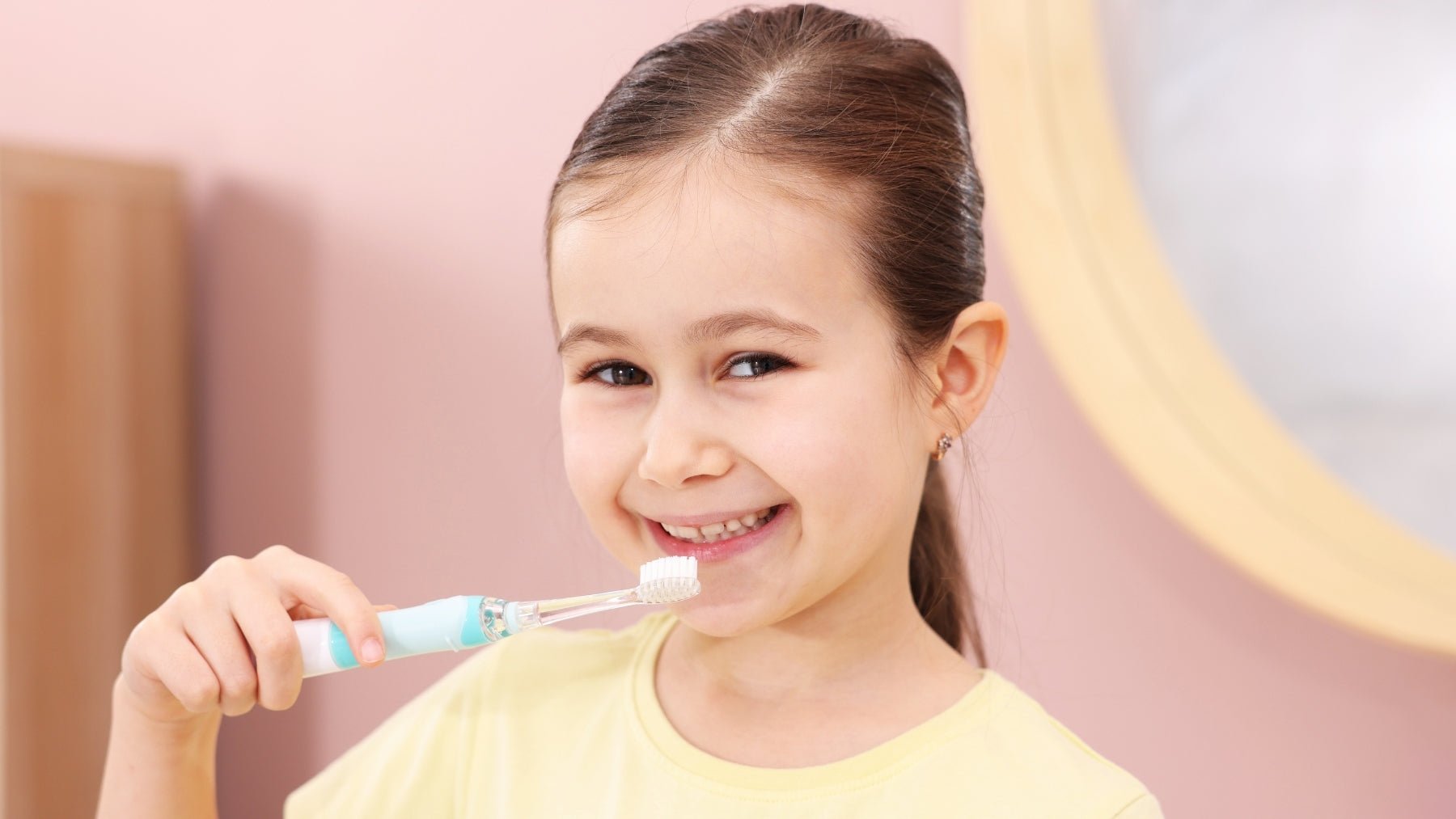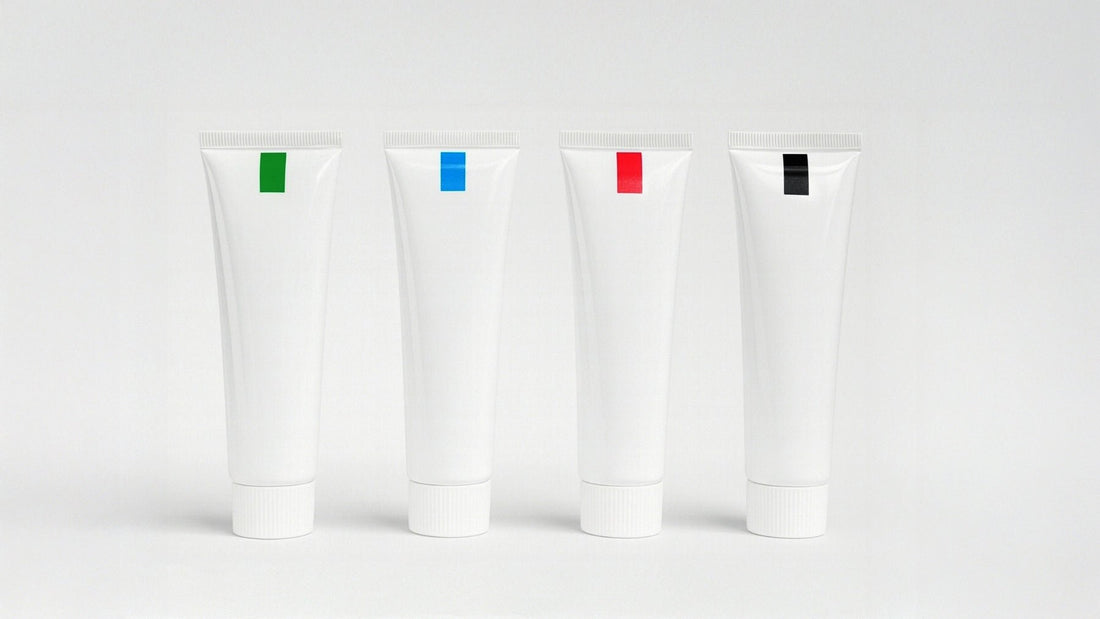Childhood is one of the most critical times for developing oral and dental health habits. Proper care habits developed during this period lay the foundation for an adult with healthy teeth. One of the most important components of this habit is using the right toothpaste from an early age. Choosing the right toothpaste, especially for children, is crucial for both protecting oral health and preventing potential health risks.
Children may swallow toothpaste while brushing or keep it in their mouth for extended periods. Therefore, the ingredients in toothpaste should be harmless and age-appropriate. Furthermore, child-friendly tastes, scents, and colors make brushing enjoyable and contribute to the development of regular brushing habits [1]. This article explains the details you need to know about choosing the right toothpaste to ensure your child has a healthy and enjoyable oral care experience.
 What to Consider When Choosing Toothpaste for Children?
What to Consider When Choosing Toothpaste for Children?
The primary reason children use toothpaste is to prevent and control tooth decay [2]. When choosing a safe toothpaste for children, attention should be paid not only to its cleansing effect but also to the safety and age-appropriateness of its ingredients. Fluoride content, products free of harmful chemicals, and the use of natural ingredients are key criteria when choosing a toothpaste for children.
The Importance of Fluoride Ratio
Fluoride is one of the substances that prevents caries by strengthening tooth enamel. The widespread use of fluoride has significantly reduced the incidence and prevalence of tooth decay in children [3]. Toothpastes can contain various fluoride salts, such as sodium fluoride, sodium monofluorophosphate, amine fluoride, and stannous fluoride [4]. The amount of fluoride added to toothpastes varies between 450 and 5000 ppm.
However, the tendency of young children to swallow fluoride toothpaste poses certain risks. Studies have shown that, despite fluoride's proven protective effect against decay, there is an increase in the incidence of dental fluorosis. Dental fluorosis is a condition characterized by permanent white stains or streaks on tooth enamel caused by excessive fluoride use during the early stages of tooth development. The first three years, when permanent front teeth are developing, are the period when the risk of fluorosis is highest. Therefore, children's fluoride intake should be carefully monitored [5].
Choosing Products That Do Not Contain Harmful Chemicals (SLS, Paraben, etc.)
When choosing toothpaste for children, the potential health effects of the chemicals contained should be considered. Choose products that do not contain SLS, parabens, titanium dioxide, or similar controversial ingredients.
Sodium Lauryl Sulfate (SLS) is a surfactant that allows toothpastes to foam, wetting tooth surfaces and loosening residue and plaque [6]. However, research has revealed that SLS can cause damage and irritation at the cellular level [7].
Parabens are used in toothpaste formulations due to their antimicrobial properties. However, they are thought to pose a risk, particularly for developing children, due to their negative effects on the endocrine system. Furthermore, a study has shown that parabens left in the oral cavity can cause gingivitis and cavities [8].
 Natural and Safe Ingredients Should Be Preferred
Natural and Safe Ingredients Should Be Preferred
Products with natural and safe ingredients support children's oral health while minimizing risks. Natural toothpastes for children contain naturally derived ingredients such as coconut oil, licorice root, calendula, chamomile, guava leaf, grape seed extract, myrrh oil, black mulberry, and cranberry extract. These ingredients have natural antibacterial and antioxidant properties, while also protecting the gums and maintaining microbial balance [9].
How to Choose Toothpaste According to Children's Age?
Children's oral and dental development varies with age. Therefore, the toothpaste content and fluoride content should be appropriate for these developmental stages. Each age group's oral structure, tooth development process, and swallowing habits are different. Therefore, choosing toothpaste appropriate to a child's age is crucial for both effective oral care and safe use [1].
Choosing Toothpaste for 0-3 Years Olds
Babies' primary teeth begin to appear between the ages of 0 and 3. This is a critical period for them to become accustomed to good oral hygiene. Because babies are at high risk of swallowing toothpaste, fluoride-free or low-fluoride (450–500 ppm) toothpastes should be preferred [10]. Furthermore, products containing natural ingredients, free of harmful chemicals such as SLS and parabens, should be used whenever possible.
The amount of toothpaste should be the size of a grain of rice for children aged 0-3 [11]. Brushing should be done under parental supervision. Preferring formulas that are mild in taste and smell makes it easier for babies to develop the habit of brushing their teeth.
Choosing Toothpaste for 3-6 Year Olds
Children aged 3-6 can now brush their teeth themselves. However, they may still have difficulty swallowing toothpaste. Therefore, products with fluoride levels between 500 and 1000 ppm are recommended. If the child is at low risk for decay, a fluoride-free toothpaste with natural mineral and plant ingredients may be preferred.
The amount of toothpaste for ages 3-6 should be the size of a pea. Children should always rinse their mouth after brushing and spit out the toothpaste and foam [12]. Even if the child is brushing alone, parental supervision is essential. Fruit-flavored and lightly scented toothpastes can attract the attention of this age group and encourage regular use.
Choosing Toothpaste for Children Ages 6 and Older
In children ages 6 and older, the majority of their teeth begin to emerge. This increases the risk of tooth decay. Children at this age are now able to spit out toothpaste. Therefore, toothpaste containing 1450 ppm fluoride can be used in children ages 6 and older, as in adults [9].
However, if your child is at low risk for cavities or there are concerns about fluorosis, it's recommended that you make this decision in conjunction with your pediatric dentist. Products with appealing flavors and colors can be used to encourage toothbrushing habits. However, care should be taken to ensure the ingredients are natural and safe.
 The Effect of Toothpaste Choice on Children's Tooth Brushing Habits
The Effect of Toothpaste Choice on Children's Tooth Brushing Habits
Tooth brushing is an important behavior that children acquire at an early age and should maintain throughout life. When choosing children's toothpaste, appealing to children in terms of taste, color, and scent makes it easier to adopt a regular brushing habit [13].
Features That Motivate Children (Taste, Color, Smell)
Sensory factors such as taste, color, and smell are key factors in choosing toothpaste that encourage children to develop regular and conscientious oral care habits. One study found that children prefer toothpastes that are red, sweet-tasting, and fruity. These characteristics transform brushing from a tedious obligation into an enjoyable and fun habit [14]. Therefore, tested, child-friendly flavors should be selected to provide children with a more enjoyable brushing experience [15].
The Role of Choosing the Right Product in Forming a Habit
Fluoride-free, natural toothpastes are a safer choice, especially for young children, as they are less likely to swallow the toothpaste. The taste, color, and smell of the product are key factors in determining whether a child will adopt this habit.
This way, children develop the habit of brushing their teeth, while parents manage the process with peace of mind. By choosing the right products, children begin to view brushing not as an obligation, but as a fun routine they choose [16].
Choosing toothpastes formulated with safe and natural ingredients supports children's oral health. You can find Perio Toothpaste here as a product that meets these criteria.
 Points Parents Should Consider When Choosing Toothpaste
Points Parents Should Consider When Choosing Toothpaste
When choosing the right toothpaste for their child, parents should consider ingredients, safety, ease of use, and the child's preferences. Toothpaste ingredients are designed based on criteria such as intended use, taste and fragrance, and age-appropriateness. Formulas developed for children differ from those developed for adults. Adult toothpastes contain higher levels of abrasives and may also contain concentrated surfactants and flavors.
It is very important for parents to be conscious and careful during this process. Because the product chosen directly affects the child's oral and dental health and contributes to the development of hygiene habits in the long term [1].
How to Check Product Labels and Content?
Parents should carefully examine the label when choosing a toothpaste. The ingredients listed on the label are important for determining whether the product is safe and appropriate for the child's age. For children under 6, parents should choose toothpastes made with natural ingredients, free of fluoride and SLS. Toothpastes formulated with natural ingredients may prefer plant-derived ingredients such as coconut oil, licorice root, calendula, grape seed extract, and guava leaf extract. These ingredients help maintain oral health while also supporting the oral flora [17].
Involving Children in the Product Selection Process
The more fun the oral care process is for children, the easier it is for the habit to become a part of their daily lives. Small decisions, such as choosing a product's scent or examining the label, help children feel they have a say in the process. This motivates them and helps them view brushing as a fun routine, not a chore [18].
Tooth brushing becomes fun during childhood thanks to products formulated with safe ingredients, age-appropriate flavors, and colors that appeal to children. This helps children develop a habit and maintain a healthy oral structure throughout their lives. For this process to be effective, it's crucial for parents to choose products based on children's toothpaste recommendations that contain natural and safe ingredients.
Source
1. Stovell, A.G., Newton, B.M., & Lynch, R.J. (2013). Important considerations in the development of toothpaste formulations for children. International dental journal, 63, 57-63.
2. DEVRİMCİ, EE, & TÜRKÜN, L. Ş. (2020). How to Choose Toothpaste? Turkey Clinics Restorative Dentistry-Special Topics, 6(2), 23-30.
3. Wong, MCM, Clarkson, J., Glenny, AM, Lo, ECM, Marinho, VCC, Tsang, BWK, ... & Worthington, H. V. (2011). Cochrane reviews on the benefits/risks of fluoride toothpastes. Journal of dental research, 90(5), 573-579.
4. Muhler, J. C., Radike, A. W., Nebergall, W. H., & Day, H. G. (1954). The effect of a stannous fluoride-containing dentifrice on career reduction in children. Journal of Dental Research, 33(5), 606-612.
5. Wright, J. T., Hanson, N., Ristic, H., Whall, C. W., Estrich, C. G., & Zentz, R. R. (2014). Fluoride toothpaste efficacy and safety in children younger than 6 years: a systematic review. The Journal of the American Dental Association, 145(2), 182-189.
6. Lambrecht, IHLJT (2011). oral care Topical Applications and the Mucosa, 40, 107-115.
7. Tadin, A., Gavic, L., Govic, T., Galic, N., Zorica Vladislavic, N., & Zeljezic, D. (2019). In vivo evaluation of fluoride and sodium lauryl sulphate in toothpaste on buccal epithelial cells toxicity. Acta odontologica scandinavica, 77(5), 386-393.
8. Ahn, GS, Park, YD, & Yoo, SM (2014). The exposure amount of paraben from commercial toothpaste. International Journal of Clinical Preventive Dentistry, 10(1), 31-36.
9. Diaz, MAN, de Oliveira Carvalho, I., & Diaz, G. (2015). Herbal dentifrices for children. Emerging Trends in Oral Health Sciences and Dentistry.
10. Wright, J. T., Hanson, N., Ristic, H., Whall, C. W., Estrich, C. G., & Zentz, R. R. (2014). Fluoride toothpaste efficacy and safety in children younger than 6 years: a systematic review. The Journal of the American Dental Association, 145(2), 182-189.
11. Cameron, A.C., & Widmer, R.P. (Eds.). (2021). Handbook of Pediatric Dentistry E-Book: Handbook of Pediatric Dentistry E-Book. Elsevier Health Sciences.
12. Cury, J. A., & Tenuta, L. M. A. (2014). Evidence-based recommendation on toothpaste use. Brazilian oral research, 28(spe), 1-7.
13. Mennella, J. A., & Beauchamp, G. K. (1998). Early flavor experiences: research update. Nutrition reviews, 56(7), 205-211.
14. Choudhari, S., Gurunathan, D., & Kanthaswamy, A. C. (2020). Children's perspective on color, smell and flavor of toothpaste. Indian Journal of Dental Research, 31(3), 338-342.
15. Stovell, A.G., Newton, B.M., & Lynch, R.J. (2013). Important considerations in the development of toothpaste formulations for children. International dental journal, 63, 57-63.
16. Davies, R., Scully, C., & Preston, A. J. (2010). Dentifrices: an update.
17. Dağ, C., & Özalp, N. (2013). Indispensable for oral and dental health: toothpastes. Acta Odontologica Turcica, 30(3), 149-56.
18. TÜMEN, EC CHILDREN'S DENTISTRY.





